Get Your Ecuador Drivers License: Guide to Driving in Ecuador
So Dena has her Ecuadorian drivers license. And she didn’t have to take a week long course, like I did to get my Ecuadorian license (detailed in the second half of this post).
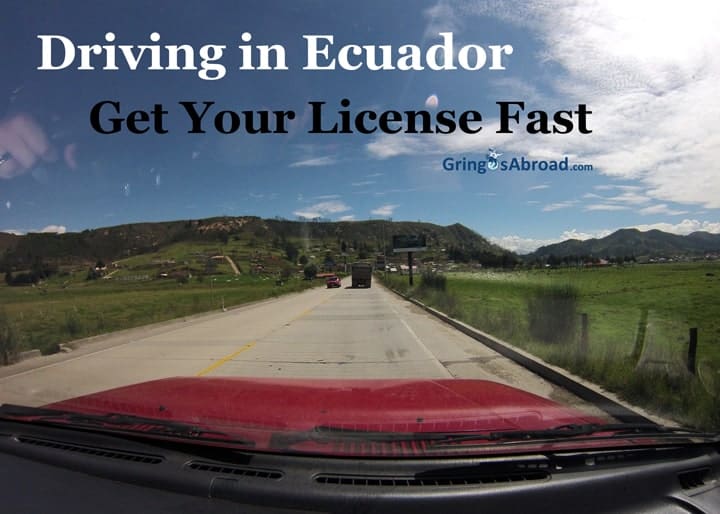
Guide to Getting an Ecuadorian Drivers License
More than a year ago, we heard about a new program by the ANT (Agencia Nacional de Tránsito), the national transit authority in Ecuador.
Instead of taking a course, the program allows for expats with a current driver’s license to apply for an Ecuadorian license based on their current one. We heard that it worked both in Quito and Guayaquil. But we weren’t sure here in Cuenca. Sometimes the rules aren’t equally enforced.
After finding the requirements online (see below) I went into the ANT office in Cuenca to confirm. Yes, it is a functioning program in Cuenca.
UPDATE (June 20, 2014): A reader on Facebook shared some recent changes: I was recently at the ANT in Quito, and, even though the website hasn’t been updated, the document from the motor vehicle admin. From your home country has to be apostilled now. Also, when I took the written test, there was an option for English, although I didn’t click on it to verify.
Read more about driving in Ecuador.
How to Get an Ecuadorian Drivers License Fast
All that we had to do, was get a letter from the transit authority in our home province of Nova Scotia.
It cost CDN$12.10 and they mailed it to our post office box in Canada and my parents brought it a few months ago when they visited. Because it was in English, we had to have it translated and notarized here in Ecuador ($26 for translation/notarization).
This document along with original and copies of Dena’s Canadian license, her cedula, a card stating her blood type and a color photo. They accepted the documents in Cuenca, scanned them all and sent them to Quito for approval. They told us to come back in 15 days.
When we returned, we were told that it was approved. The next step was to go to Paute to write the exam and get the license.
A few days later we headed to Paute and submitted the papers. They sent us to the other side of town for a eye and motor skills test (at the Sindicato de Choferes Profesionales del Cantón Paute, Centro Marginal Rio Cutilcay S/N y Abdon Calderon).
The cost was $20 for the examen psicotecnico (psychological examination). With the document, we headed back to the ANT offices. Dena got in line for the exam (they only give the tests Tuesday and Thursday mornings). She got a perfect 20/20!
To pass, you have to get a minimum of 16 out of 20. The tests are 20 multiple choice questions taken from a bank of 400. You can download the pdf file from the ANT site to practice/study. They even have an online practice component.
After just a few hours in Paute, we walked out with her license. Now she can drive in Ecuador.
This is a big deal for Dena. The only other option was to take a driving course in Cuenca – where she would have to drive a standard. While she can drive stick-shift, she isn’t comfortable with that in the city. Now that she has her license, we are shopping for an automatic car…
Don’t Forget Your License Certification: If you are still planning your move to Ecuador, don’t forget to get your license certification. It hardly costs anything and you’ll have it for when you want to apply for your license.
Dena is a Professional Driver: Because of how the letter was written by the transit authority in Canada, Dena was rated as a professional driver here in Ecuador. The standard license in Ecuador is a Tipo-B (Type B). This allows cars, vans, and pickup trucks.
She was issued a Tipo-C license which is a professional license. She can drive everything allowed by the Tipo-B plus buses (capacity up to 25 passengers) and full size trucks.
Requirements: Exchange of Foreign License for an Ecuadorian Drivers License
The requirements are here: Exchange of foreign driving license Ecuadorian driver’s license (Canje de licencia de conducir extranjera por licencia de conducir ecuatoriana). The url has been changing. In case the link doesn’t work, please visit www.ant.gob.ec and search “extranjera”.
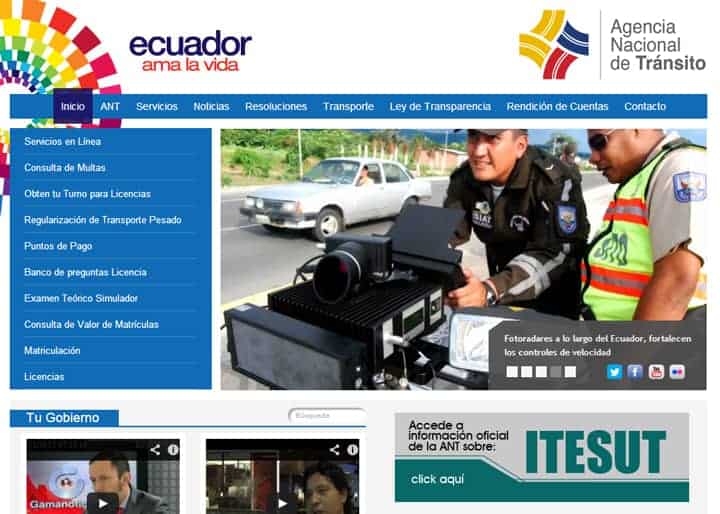
Requirements in Spanish. See translation below:
- ORIGINAL Y COPIA A COLOR DE LICENCIA DE CONDUCIR EXTRANJERA VIGENTE
- ORIGINAL Y COPIA DE CÉDULA DE IDENTIDAD O PASAPORTE, VISA Y CENSO
- ORIGINAL Y COPIA A COLOR DEL CERTIFICADO DE LA LICENCIA VIGENTE EMITIDO POR UNA DE ESTAS INSTITUCIONES: POR LA EMBAJADA O CONSULADO DEL PAÍS DE ORIGEN EN EL ECUADOR, EN CASTELLANO, O POR LA EMBAJADA O CONSULADO DEL PAÍS DE ORIGEN DE LA LICENCIA DE CONDUCIR DE LA REPRESENTACIÓN DIPLOMÁTICA DEL PAÍS MÁS CERCANO, EN CASTELLANO,O , POR LA ENTIDAD DE TRÁNSITO AUTORIZADA DEL PAÍS DE ORIGEN, EL MISMO QUE EN CASO DE NO ESTAR EN CASTELLANO DEBERÁ SER TRADUCIDO Y NOTARIADO EN EL ECUADOR, O POR LA ENTIDAD DE TRÁNSITO AUTORIZADA DEL PAÍS DE ORIGEN, APOSTILLADA EN EL CASO DE QUE SE EMITA EN CASTELLANO.
- ORIGINAL Y COPIA DEL CARNET DEL TIPO DE SANGRE
- UNA FOTOGRAFÍA ACTUALIZADA A COLOR TAMAÑO CARNET
Requirements for Ecuadorian Drivers License
- Original and color copy of a current foreign driver’s license.
- Original and color copy of Ecuadorian cedula or passport, visa and censo.
- Original and color copy of certificate (letter of certification) of current license issued by one of the following institutions: 1) by the embassy or consulate in Ecuador of your country of origin, in Spanish, or 2) by the embassy or consulate in the nearest country of your country of origin, in Spanish, or 3) by the authorized transit authority in your country of origin, if not in Spanish, it must be translated and notarized in Ecuador, or 4) by the authorized transit authority in your country of origin, apostilled if issued in Spanish
- Original and copy of your blood type card
- A current color photograph, “card sized”.
Offices for Agencia Nacional de Tránsito
Here are the contact details for Cuenca, Quito, Loja, Santa Elena and Otavalo. Guayaquil is managed by another transit authority.
For other locations, or to confirm the latest information, check Trámites Ciudadanos. It is a central information page run by the national government. I have used it many times to find information about certain legal processes.
The Spanish term “trámites” is very common here. We don’t really have an equivalent word in English. We usually say “paperwork”. A couple of dictionaries that I checked translate it as “formalities” or “processes”. Either way, it means a lot of photocopying…
- CUENCA – AZUAY
- Teléfonos: (593) (7) 409 21 72 Email: contactenos@ant.gob.ec
- Responsable: María Fernanda Tenorio Vásquez
- Dirección: Calle El Salado Av. Don Bosco Horario de Atención: lunes a viernes 8:00 a 16:45
- PAUTE – AZUAY
- Teléfonos: (593) (7) 225 16 91 Email: contactenos@ant.gob.ec
- Responsable: María Soledad Sarmiento Loyola
- Dirección: Av. Luis E. Vásquez José V. Izquierdo Terminal Terrestre de Paute Horario de Atención: lunes a viernes 08:00 a 16:45, dos últimos sábados del mes 09h00 a 14h00
- QUITO – PICHINCHA
- Matriz ANT
- Teléfonos: (593) (2) 382 88 90 Email: contactenos@ant.gob.ec
- Responsable: Ing. Paola Carvajal
- Dirección: Av. Occidental SN José Sánchez Horario de Atención: lunes a viernes 08:00 a 16:45
- Quito has six other branches. Check Trámites Ciudadanos for the addresses.
- LOJA – LOJA
- Agencia Loja
- Teléfonos: (593) (7) 257 46 83 / (593) (7) 258 60 63 Email: contactenos@ant.gob.ec
- Responsable: Richard Mauricio Carpio Ocampo
- Dirección: Bolivia y Argentina Policía Nacional Horario de Atención: lunes a viernes 08:00 a 16:45, dos últimos sábados del mes 09h00 a 14h00
OTAVALO – IMBABURA(Update July 10, 2013: This office is not accepting documents for this program.)
- SANTA ELENA – SANTA ELENA
- Teléfonos: (593) (4) 293 12 52 Email: contactenos@ant.gob.ec
- Responsable: Ligia Edith Vargas Perez
- Dirección: Av. Carlos Espinoza Larrea Calle 25 de Diciembre Horario de Atención: lunes a viernes 08:00 a 16:45, dos últimos sábados del mes 09h00 a 14h00


How to Request the Certification Letter
UPDATE (June 12, 2013): A number of readers asked how we requested the certification letter. I’m sure that there are lots of ways to do it, but here is what we did. I called the transit authority to confirm how it worked. Because I couldn’t come into the office, they told me to fax my request. Here is what the letter said:
Registry of Motor Vehicles
Dear RMV,
My name is Dena Haines, born XXXX, XX, 19XX. I’m applying to get a drivers license in another country and they require that the issuing transit authority (Service Nova Scotia – as I have a NS License) issue a certification that my drivers license is valid. It is valid until XXXX, XX, 20XX. My master number is: XXXXXX123456789
I am requesting a certified letter at the cost of $12.10.
I also included my credit card number and mailing address in Nova Scotia. The letter arrived three days later.
Do you have your Ecuadorian license? How did you get it – the old way or the new way?
Are you planning on getting your license?
The following section is a summary of the process that I went through to get my license in Ecuador. As you’ll see, it has changed quite a bit since back in 2011.
How to Get a Drivers License in Ecuador
Over the past few months, we’ve been working to get licensed so we can drive here in Ecuador. And we’ve spent significant time shopping for and then registering our car.
Here is the process to get your license and a car, should you be brave enough to try. . .
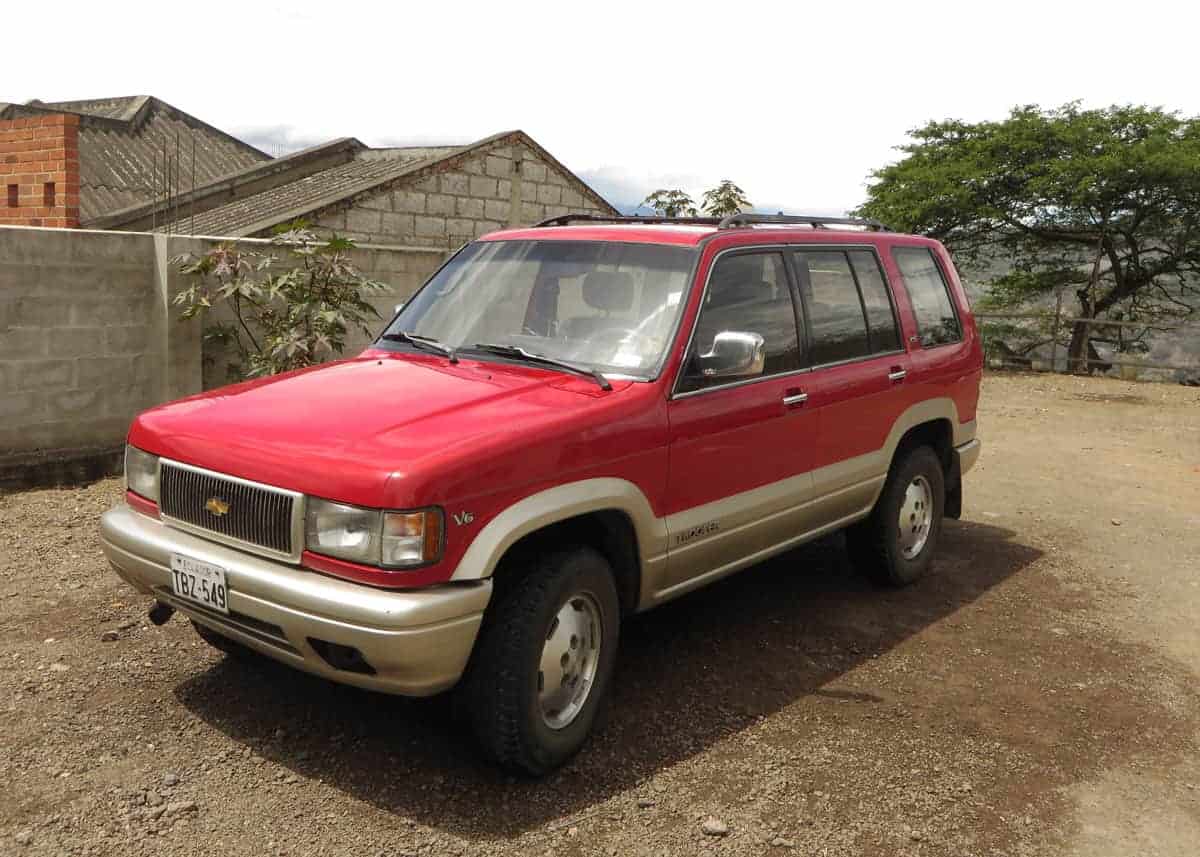
Step 1: Paperwork
Covers the initial steps of getting the license – namely registering for the driver’s course. Not as simple as it sounds – a dozen different documents are needed (some expected, some bizarre) and it’s a goose chase all over town to get things in order.
So it time to get my license. After almost a year and a half here, I’m tiring of taxis and buses. Hired vans are nice, but I really want to drive – and explore.
Whenever we visit another city (in Canada, the States, the Caribbean, or South America) we always rent a car. But I haven’t driven in Ecuador since we’ve lived here and I really miss it.
Two days ago I registered for a driving course. Here, even if you’ve been driving for years, they require a course (the accelerated one is 35 hours – done in a week), before you can write the government-administered exam. Well I’ll never say that the Canadian government requires lots of paperwork.
Just to register for the course, I needed to provide:
- a police report (with 2 copies, and a special photo)
- 2 copies of my visa
- my passport ( and 2 copies)
- my Ecuadorian identification – plus 2 copies
- a card stating my blood type (and 2 copies)
- 2 more copies of the special photo (taken outside of the transit authority)
I also had to do a reflex, motor skill and eye test, along with a psychological exam.
And of the most bizarre thing that I need to provide, is my high school graduation certificate. After all these years, the first time I had to show it (for anything), is to get my driver’s license in Ecuador.
Who moves to a foreign country and brings their high school graduation certificate? Especially when high school was “a long long time ago”, and the pride of having it has worn off just a little?
Anyway, we had stuffed that into a safe (along with a few other “really important” things) that we stored in Canada.
After a number of emails and phone calls between our lawyer’s office and the driving school, we learn that a color copy will be acceptable.
So today, I have to have my (nicely scanned color copy) notarized in duplicate. Without, they will not issue a license. Not sure what Canadian geography and political science has to do with Ecuadorian driving laws, but a rule is a rule – right?
So the course, put on by ANETA (Automovil Club del Ecuador) which is Ecuador’s version of CAA or AAA, costs $173.44. Plus the $5 for the police report, $2 for the very nice photos, $3 for the card stating my blood type, about $12 in taxis and the notarizing of my graduation certificate. After I pass the course, I then have to go get my license, with a similar set of paperwork.
And while we can tackle just about every type of task that comes our way, I needed some help on this one. A good friend, came along and helped with some of the steps I couldn’t get my mind around. He recently got his license – so he knew how to do it.
Step 2: Driving Course
This step covers the actual course, the classroom and the practical driving components. This was the easiest and most fun part. Just putting in time for a week (35 hours to be exact) to get my certificate to prove I passed. The course was well put together – but I think I could have found something else to do with my time.
On Sunday, I completed Step 2 of getting my Ecuadorian drivers license. I completed the seven-day driving course, with a planned 35 hours of learning.
I’ll be honest – I was dreading the week. I know how to drive. I’ve been driving for half my life and have always owned my own vehicles. What do I need 35 hours of training for?
Well, the course is well produced. The instructors were excellent and I learned the laws. The laws are different here than Canada. Many are the same, but there are some differences. Like you can pass on the inside lane – legally. The stipulation is that you have to feel that its safe.
Each day consisted of 3 hours of driving and 2 of classroom – Monday to Friday. On Friday morning I took my Practical Exam and scored a 20! To those used to having school scores out of 100 – it doesn’t sound so good – but here – a 20 is perfect! Not one mistake – at least none that the instructor noticed. (Being a foreigner has its benefits. Immediately I’m “interesting” and the instructors want to ask all kinds of questions). So who know if my driving is perfect, but I’ll take it.
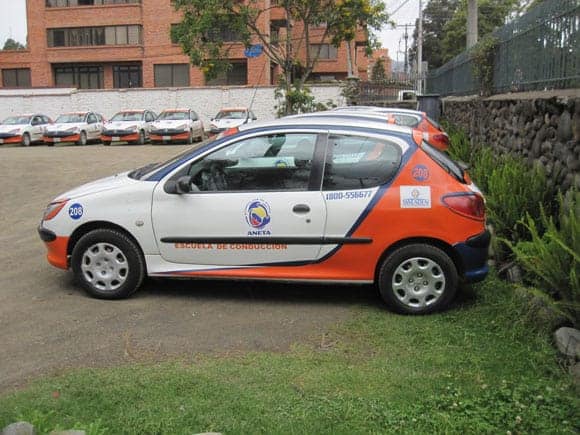
In the afternoon, there is a written exam. Of twenty questions, you must get 16 correct.
They are multiple-choice so it’s not that hard. For me the language barrier was the biggest problem, but I still passed with an 18/20.
What makes me laugh is that four of the students failed. They are Ecuadorian and knew how to drive. The instructor made everyone who failed feel really good, by reading out all their errors and highlighting that: “This foreigner who can’t read well passed with an 18 – and you are Spanish and couldn’t pass”.
Of course, it doesn’t really make my ego burst, being the bad reading extranjero (foreigner) – but I’ll take any compliment, however backhanded.
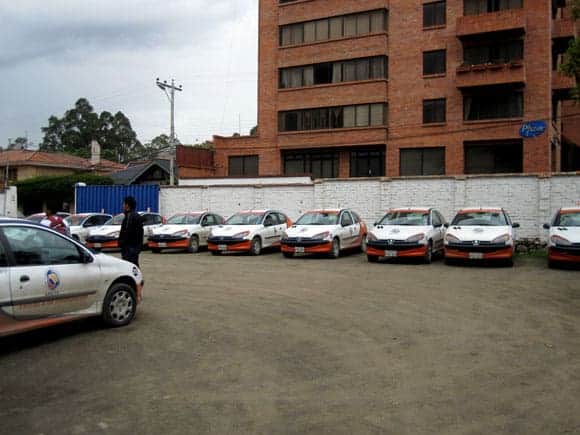
Saturday and Sunday consisted of three segments: First Aid, Psychology and Mechanical. The last thing to do is sign a paper this Wednesday.
Next Wednesday I can go pick up my certificate and head over to get my real license. The Transit Commission requires another 20 question exam, and another pile of papers and I should walk out with my license. Simple, right?
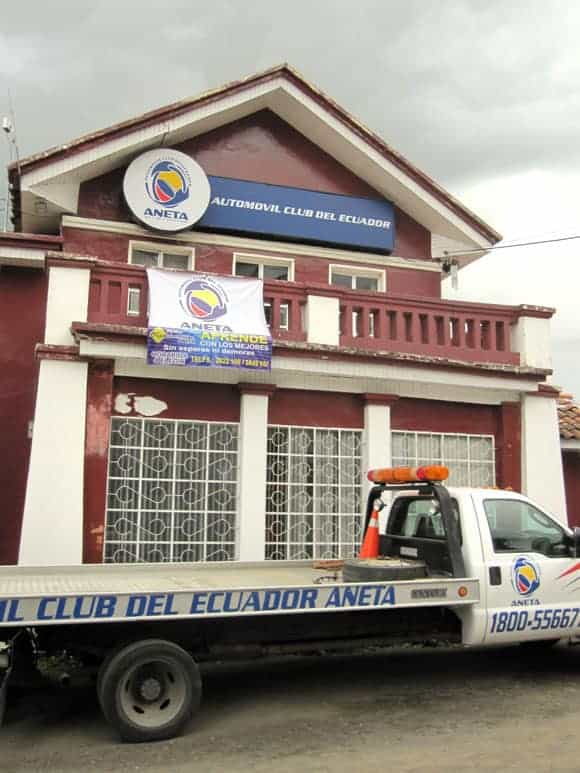
Step 3: Paperwork (Transit Commission)
Easily the hardest (read: frustrating) part so far. There were personnel problems and mechanical problems that made the wait for my driver’s test last more than one month. Learn about the dreaded Comisión de Tránsito in Cuenca, and how the process works. But in the end, it all went okay and I have my license in hand.
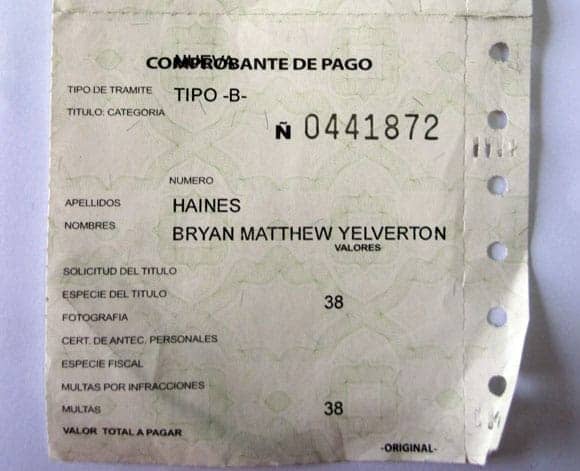
So, I bet you’ve been wondering about my drivers license, eh? You’re probably thinking: “He failed the exam and was too embarrassed to put the next post”. Well, after I started this process, that thought did go through my mind. But. . .
I can finally say (with much relief) that this is the final step in getting my license.
I have my Ecuadorian Drivers License!
The process began just two short months ago. The first week of December I registered for my course – which is required for everyone (even if you have 16 years driving experience). This process of registering for the course took the better part of a day.
The second part was the course itself. It was neither frustrating or difficult. The quality of the course was good and the instructors were excellent. The course ended towards the end of December and I got my certificate from the driving school on December 26th. This is the paper I needed to go write my exam at the Transit Commission.
The final part was the famed and dreaded Comisión de Tránsito here in Cuenca. During the month of December, it had been shut down as the bosses tried to cleanse the place of corruption. Apparently, a number of the workers were overcharging the fees and pocketing the difference. Nice. (In fact, when they finally reopened, there was a huge sign outside the door advising what to pay – and not to pay any more than listed fees.)
- And so I went the first week of January to write the exam and get my license. The guard at the gate advised that they were understaffed and so they would be closed for the week.
- Second week of January: Camera is going to be broken all week. Come back on Monday
- Third week of January: See above
- Fourth week of January: They are open, and a full month backlog of applicants all arrive the same morning. They are processing about 40 people every 20 minutes – it was very impressive. I arrived just 30 minutes after they opened – so I only had to wait an hour and a half to start.
Once I aced the exam (20/20 – yes, its not hard at all) I had to visit the staff doctor, so he could check my eyesight, eye color, height, etc. Then I had to go to a third office where I stood in line for another hour, then I paid the $38 and got more paperwork that I had to take to the now working camera room. In just a couple of minutes they snapped the picture and printed the license.
And I was done. It didn’t seem so hard. . .
I easily made 100 photocopies (probably much more) of my passport, high school certificate, blood type, power bill, driving course certificate, and every other paper I have with me here in Ecuador. I easily made 25 trips for paperwork, tests, and appointments with closed offices. And in the end, the cost was around $300 – counting the course, the license fee and photocopies.
About the photo: While I was in the line to pay – I was also thinking that this was the line that I would receive my license as well. After I paid and gave them all my paperwork they handed me this slip of paper – “THIS is my license?”
It looks a little unofficial, doesn’t it? As it turns out, its a receipt that I take to the photo room where they make the licenses. I felt kind of dumb, but at least I didn’t tell anyone, right?
So now, we have a car and a license. More on vehicle registration next week. (PS – it’s just as crazy as the licensing process).
How to Buy a Vehicle in Ecuador
Learn what we learned while car shopping here in Cuenca. Things work quite similarly to the system at home. The dealers are tricky, and try to hide and deceive.
The biggest difference is that old cars still cost a fortune. A shocking fortune, actually. Here’s the full guide: How to buy a vehicle in Ecuador.
Stick Shift Transmissions in Ecuador
If you’re coming from Canada or the United States there’s a good chance that your car is an automatic.

But here, automatics are very rare. Some of the large SUVs are automatic (like the Troopers and Monteros) but almost every car and all the trucks are stick-shift. There are benefits to driving a standard shift – like the better gas mileage you’ll get – and they are much more fun to drive.
Here’s a great article about driving standard transmission: Learning to Drive a Standard Transmission Made Easy



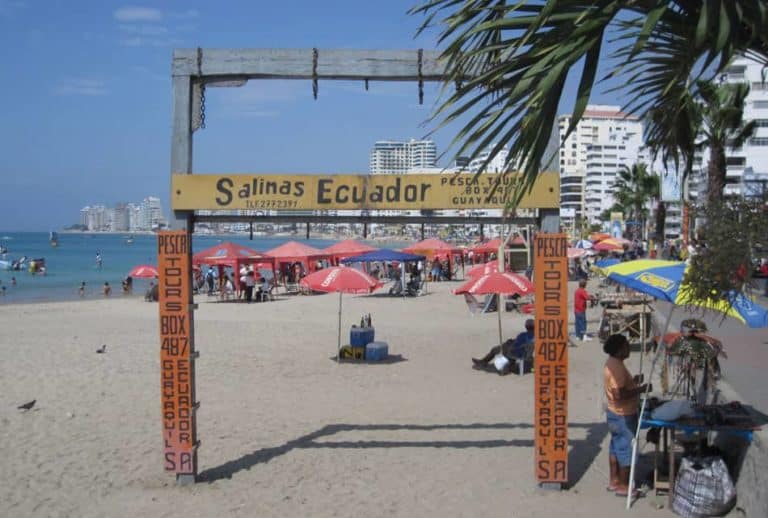
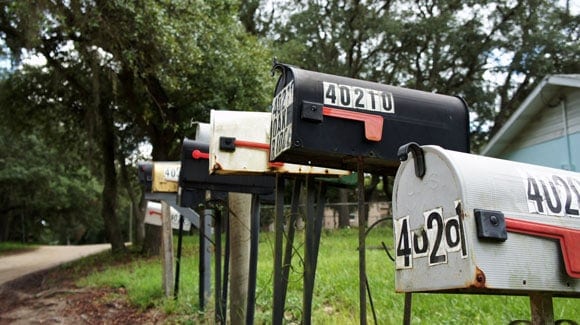
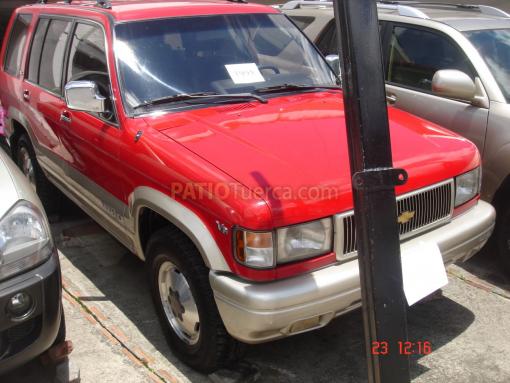

Hi,
I am moving from Quebec to Riobamba pretty soon and I don’t want to give up my drivers’s license here before I get the one in Ecuador. Any tips for me? Also, how do I get that blood card?
Thank you
I work for an insurance company as an underwriter. We had an insured walk in with an Ecuadoran license. We noticed that it said 27 puntos. His wife’s license said 30 puntos. We need to know how the point system works in Ecuador. Can you help me out?
I don’t think the question having to do with whether there is an upper age limit on driving here was qualifiedly answered. Very important for a lot of us.
Does anyone know if there is an upper age limit to getting an Ecuadorian license? I was recently told by an Ecuadorian that after age 70, licenses are only issued for use within one’s home city – and that the term of the license is for 3 years with a requirement for an annual renewal. I am 71 years old with a valid current driver’s license from the US with five more years left on my US license. Is it true that I would not be able to drive on the pana or anywhere else in Ecuador except in my home village even with a valid Ecuadorian license?
Hello, I have looked on-line for this answer with no luck. Back in Canada I’m a Driving Instructor. Would that consider me to be a professional driver, and I recently heard that if you have more than 1 license, ex Car and motorcycle the process is much faster. As anyone heard this as well.
Hi Brian,
My question is can you take the written test in English or does it have to be in spanish?
My next question is, is their anyway to get the driving question’s and answers in english to practice them before taking the test?
Thanks,
Phil
Test is in Spanish. With some basic Spanish you’ll do fine. The questions/answers are available to study in advance. There are links in the comments below.
I appreciate the information on this website about how to get a driver’s license fast. Unfortunately, in my case, I tried for the “fast” route of “Canje de licencias” and it turned into a two month nightmare of going from one place to another to another in what seemed like an endless paper trail. In other words, it was anything but fast and efficient.
I think it important for readers to know that the “Canje de Licencia” is only available in a handful of cities, such as Quito, Guayaquil, and perhaps Cuenca. I live in Riobamba, the 10th largest city in Ecuador with more than 150,000 people in it, and the only things I could get done here were the Psychosometrico (psychomotor) exam and the bank payment (for licencing fee). Everything else, from translation of documents to notarization to blood type card to written exam to registration, etc. had to be done up in Quito (a three hour drive away, with most things only being done during week days). The only way to get things done locally is to drop the attempt to get a license by exchange (“canje”) and obtain a driver’s license by taking the 6 week driving class.
One thing that has changed in recent years is that you can no longer just walk in to an Agencia Nacional de Transito whenever you feel like it. You first have to go online and register, then the computer will assign you a date (usually the next day) and time. You have no control over either. This is perhaps no big deal if you live in Quito or Guayaquil, but makes things hard to plan if you have to travel from a long ways away.
Also, you will be given an address on your appointment page that has NOTHING TO DO with the ANT address. (You’ll see it next to “Agencia” and “Dirección.”) Advice to anyone out there who needs to get your license: just IGNORE this address and go straight to the ANT. (In Quito, this is Avenida Antonio José de Sucre y José Sánchez)
Also, letters from the Department of Motor Vehicles in your own country now have to be apostilled, then translated. Translations include not only the letter (usually one page) but the apostilled cover pages as well, and they can only be done by people who have official approval by the Ecuadorian govenment (either in your own home country, e.g., Ecuadorian Embassy, or in Ecuador, e.g, a translator whom a judge assigns you after you turn in a written request to have this work done). Thus translation work (followed by notarization, which the translator has to sign in the presence of the notary) will now generally cost you $50 to $80, depending on which route you go, and it will usually take anywhere from a week to a month. (I got lucky and discovered a group in Quito who did it in 2 days: they are called “Lenguatec” and their address is Luxemburgo N34-123 y Holanda; you can also contact them at http://lenguatec.com/contact/ or Phone: +593 (2) 246-0237)
Many of the troubles in my case were probably unique to me, in that I have had an Ecuadorian cedula since 2005, but when I got married in 2009, the judge punched two holes in my cedula to show that I was no longer a bachelor/”soltero”. I had no problems with this until 2014, when I went to the ANT in Quito and they refused to accept my cedula and told me to go get a new one. I then tried to show my passport and visa (since the requirements pages on the ANT website say these are also acceptable) but these, also, were not accepted. Getting a new cedula is also not easy or fast (partially because one has to first get an empadronamiento…which is also not easy, fast, or even possible if you don’t live in Cuenca, Quito or Guayaquil). In all, I spent several weeks just on this step alone.
Two more comments about the actual process at ANT, then I’ll end. First, I did not have to have two carnet-sized photos. I only used one, which I pasted on my application. The ANT now takes the photo that will go on your license. Second, the written exam is by computer but most of the questions they give you are different from what the bank of questions (that you can consult on the internet) contains; this is because they have recently rewritten the exam. (Most questions are easy, but the one question that flummoxed me was one asking me to state what kind of license is an “F” type license. “How should I know?” I thought. “I just want a ‘B’ license!”)
Final Comments: For anyone who lives outside of Cuenca, Quito, Guayaquil (and perhaps Ambato), getting a license by “Canje de Licencias” is neither easy nor fast. Be prepared to be heavily inconvenienced. Also, as with most things in Ecuador, there are often more requirements than what an official ANT requirements checklist contains.
Hi Bryan,
Do you happen to know if the apostilled/translated/notarized state certification will be accepted if it is more than 90 days old? My certified record from my state was issued almost 4 months ago but has taken a while to get apostilled, translated and notarized. Do the documents for a drivers license get “stale” like they do for a visa?
Karl
I spoke with an expat from the States a few days ago and he told me that the current requirement is that it be no more than 90 days old.
Can you get the document again?
I can get it again. Like everything else, it’s just a matter of more time and more money. However, since I’ve already paid the fees for the document, apostille, delivery, translation and notary, I think I’m going to give it a try and see if it will slide by. What do I have to lose, right?
You never know. They might accept it.
I went through this procedure a few months ago. I had a friend in Missouri go to the DMV to get a copy of my driving record and she mailed it to me. Had a Ecuadorian friend that hauled me around getting everything together and when I was notified by e-mail we went to Paute for the written test which was easy because my friend was in the test room with me and told me the answers! Ha! Anyway I walked out with my Ecuadorian license good for 5 years so now if I travel I can rent a car and no need for a US license anymore! Very helpful post!
Nice. Glad it all worked out for you. It sure is nice being mobile…
Hello ,
I too am a gringo living here in Ecuador,*** near Guayaquil***, my wife and I ,*** shes Ecuadorian***, have been living here since 2010. Originally we were Rhode Islanders,….I have done everything here and have my license , however I was thinking of getting it upgraded to a professional one. I have seen that they offer courses to obtain this but I also saw that you stated that your wife got hers fairly easily. My grasp of Spanish es muy bien,, pero I m a little afraid of taking a course that costs 2000 $ only to find that I cant understand half of what the instructor is saying .
It’s was kind of funny. We didn’t apply for a professional license – but based on the report sent by the transit authority in Nova Scotia, ANT rated her as a professional driver. Now that you have your license, I don’t know if you can reapply. But if you could, the reapplication would have to be based on the letter from your home state certifying the type of license that you hold there.
Hi Bryan, I have purchased my driving record from Washington State. Of course it is in English and I can get it translated. My question to you is with regards to exchanging my US license for Ecuador. Is that required? I wouldn’t give up my US drivers license as I would need it to drive when visiting, renting a car in the USA. Thanks, Lenny.
No, you don’t actually exchange it – you just use it as the basis for your Ecuadorian one. They take a color copy in Cuenca when they send it to Quito – but you have to have your original with you then. But they don’t actually take your current US license.
Regarding the number 4 requirement does this mean that no apostille is needed if the transit record is not in spanish? We have our records but not apostilled. (They are in English…hoping we can just have them translated & notarized here).
Also, any recommendations of locations to get your blood type card?
Thanks!
From how I understand it, that is correct. The document will be notarized in Ecuador after it is translated.
You can get the blood type card at the Red Cross – that is where I went years ago. But I don’t recommend it. The lady taking the samples was wearing gloves stained in blood from the hundred people before me. Maybe they have improved but it was disgusting back then. For Dena’s card, we just went to a clinic and asked for the card. It cost just a couple of bucks and it was done quickly. And it was clean and professional.
Hi Bryan and Dena,
I just wanted to thank you for your informative website. I was able to transfer my Canadian license and I am now a proud holder of an Ecuadorian professional license. All thanks to the information you provided. I used the book to study by also used the online simulator that you can find on http://www.practi-car.com To the left of the page on the menu you will find a link to the “Simulador Del Examen”. Hopefully that link will help others practice.
Thanks Jill – this is very helpful. I’ve recently heard from many expats that they are going to be getting their license here in Ecuador.
I have looked at the ANT website and have found the driving test questions which I have downloaded. Do you know of a link that shows the correct answers? Also, you state there is and online practice component, do you have a link for that as well please?
The correct answer is shown in red in the downloadable pdf file.
I looked for the online practice and couldn’t find it. I’ve heard that it’s there – but it is a new feature since I took my exam.
Oh, I more item to add. Once you submit your paperwork initially for processing you can check the status of your application here:
Canadian paperwork must be odd, as they approved me for a ‘D’ – professional Bus drivers license. I just took the ‘B’ – regular car license thought as the renewal process looked like a nightmare for a ‘D’.
Nice, I didn’t know that the status was available online. Very nice.
Congratulations on your bus license. Another employment opportunity…
Hi Bryan, excellent info once again! Gathered the info you listed (for Manitoba, Canada I just requested a Drivers Abstract) and took it into the Quito ANT office, just over a week later went back in, stood in a few lines, but now have my license. Nice.
The Otavalo office is not help (maybe you can remove info?) they just send you somewhere else. In Quito I recommend the main office which has moved to Avenida Occidental y Carlos Quinto (or Carlos V)).
Thanks again!
hello
i am an expat in Thailand
i have an Australian and Thailand license for both car and bike
there is no certificate here to get
i was thinking of checking out Ecuador for a few months to see if it was better than Thailand – could i just use an international license?
Also, what about motor bikes there – can i rent one?
I like the beach so this is where i will be heading – I am 56 years old so no all night rave parties – just somewhere nice, quiet, lots of seafood and cocktails.
Any suggestions are welcome.
If you are here on a tourist visa (T-3), I believe you can use an international license. Once you get a visa you’ll need an Ecuadorian license. There are lots of motorbikes here, but I haven’t seen them for rent. Maybe on the coast, but in Cuenca I’ve only seen car rentals.
HI BLACKJACK … r u in Ecuador now ?? im a swiss + live in Chiang mai + retired 51 . i have to leave 2 from here i cant stand the danger on the road + everywhere else here in THAILAND, need peace 2 . Can i change my Thai licence to one from Ecuador , because the Thai one is a jock . U know … the problem is u get no Certification here in Thailand ………….. HELLO BRYAN … U R THE EXPERT HERE , WHAT DO U THINK ??? Please help me , because i want to leave from Thailand asap… Ecuador is closer to Switzerland in feel+ to learn SPANISH is easier than thai 2 …. Love to here from U , THANKS .
You shouldn’t have any trouble converting your license here – but until you actually apply and have it accepted you can’t be sure. Some friends from Switzerland got their licenses a few years ago on this system. The province of Guayas was offering this before the rest of the country. If they don’t accept your license you can take a week long course and then get it. It isn’t hard.
Hello Black Jack. I also live in Thailand and think about checking out Ecuador early next year. I’ve been living in Phuket for the past 14 years and get really tired of it. Would be nice to get in touch with you. Shoot me an email, afghanistan-mex@hotmail.com
Cheers,MEX
Alberta requires a notarized authorization to obtain the letter. I find it a bit confusing they are requesting the authorization to be notarized by a Notary licensed in Ecuador. I’m thinking I may just take the drivers course. It may be less of a headache.
They clarified the information. I need to go to the Canadian Embassy in Quito or Canadian Consulate in Guayaquil to get the Alberta drivers abstract request notarized…didn’t know there was a Canadian consulate or embassy in Ecuador. They also felt compelled to inform me that I cannot hold two drivers licenses at the same time. I am seriously considering taking the drivers test.
More on getting an Alberta drivers abstract. The easiest method of getting it is to have a trusted friend pick up for you at a Registry Agents office in Alberta. It’s a simple process. I fill out a form and fax it to the office, my friend goes to that office and fills out a form of intent and they walk away with the original abstract which they can courier to me in Ecuador.
Hey there! I’m in Otavalo and really appreciated your blog about the drivers license process. Can you clarify something for me? I simply downloaded my driver record online but you talk about having a letter written from your dept of motor vehicles in Canada. Was that necessary? If so, what format must it be in? I have all the other documents but am waiting to translate my driving record til I hear from you. Thanks!
Camille
sorry, I think you already answered my Q way down the page. Hadn’t seen it. Sure appreciate this info, thanks!
What they want is certification that you actually have a valid license. I’m sure it differs between provinces and states – but it should state that they are certifying your license. Let me know how it works out.
Just more great info to have as we continue to get ready to make our move. Keep up the good work. And thanks!!
Bo & Lori
That’s great! So glad they have this program now! I wish I had known about it a couple of months ago. We were told we had to go to driving school, so we went to one here in Quito that is used to working with foreigners with valid driving licenses from their own country. They told us we had to pay for the classes, but didn’t have to actually attend them. We took all the tests there (vision, motor skills, written, they waived the actual driving test), but didn’t have to sit through the hours of classes. So basically, I guess we paid for the documentation. 🙂 Two weeks later, our documents were ready, and we picked them up and proceeded as usual at the Transit Office to get the actual licenses.
The written test IS in Spanish, but multiple choice and super easy. I also got a 20/20. I took several practice tests online, so I was very familiar with the questions. You can also buy little practice booklets outside the Transit Office that have all the questions. It’s a great way to practice Spanish too and learn a bunch of words you may never learn in a Spanish class!
Glad to hear it went well for you. When I took the course, I had to attend every day. It was actually well organized and I learned a lot of Spanish.
Hi Bryan, you certainly deserve a pat on the shoulder. Nobody provides us with such COMPLETE and USEFUL information like you do. We all eagerly look forward to your newsletter.Every piece of information from others is SOLD for the price of a subscription.You are doing a fantastic job of preparing us.
Thank you,
Marlene in Germany
Thanks so much Marlene. We are thrilled that you are enjoying the content.
Bryan
Brian & Dena,
Always enjoy your blogs. This one especially good! There was talk earlier this year of them having an English version for the written test. Do you know anything about that? Thanks,
Kenny
No, I haven’t heard about that. When I took the driving course a few years ago, one of the requirements was to read and write Spanish.
Good to hear that she got it. The law in Ecuador refers to one’s home country and the Canadian Embassy in Quito would have nothing to do with it; and, offered no advice. Perhaps you could inform them of your experience.
I took the course with ANETA, the Ecuadorian drivers club, like CAA and AAA. It has the best reputation and everyone there, in Tumbaco, are very nice. The standard of driver training is not like in Canada. Our daughter took it before me and was left with incomplete learning and accepted bad habits. I took it and, since I enjoyed the friendly instructors, did not comment on their bad habits. In a country where there had previously been no standard, at least things are moving in the right direction.
I also took the Aneta course and it was good.
While Canada doesn’t offer verified license at their consulates, there must be some consulates that do. Either way, there is always the option to get the letter from your home country.
What is a “certificate (letter of certification) of current license”? Why would my country produce these?
I wasn’t sure that I could get it – but when I called the Registry of Motor Vehicles (Nova Scotia’s transit authority) they knew just what I was asking about. They mailed a one page letter that stated that said they Dena had a valid license. They noted the type of license, her master number and how long she had the license.
I look forward to a future picture of the week showing Dena driving the bus you guys buy for her to drive.
🙂
Bryan, were you able to request that letter from N.S. online or via a phone call?
I actually had to fax a letter with our request, mailing address and credit card info. It arrived in our NS mail box within 3 days.